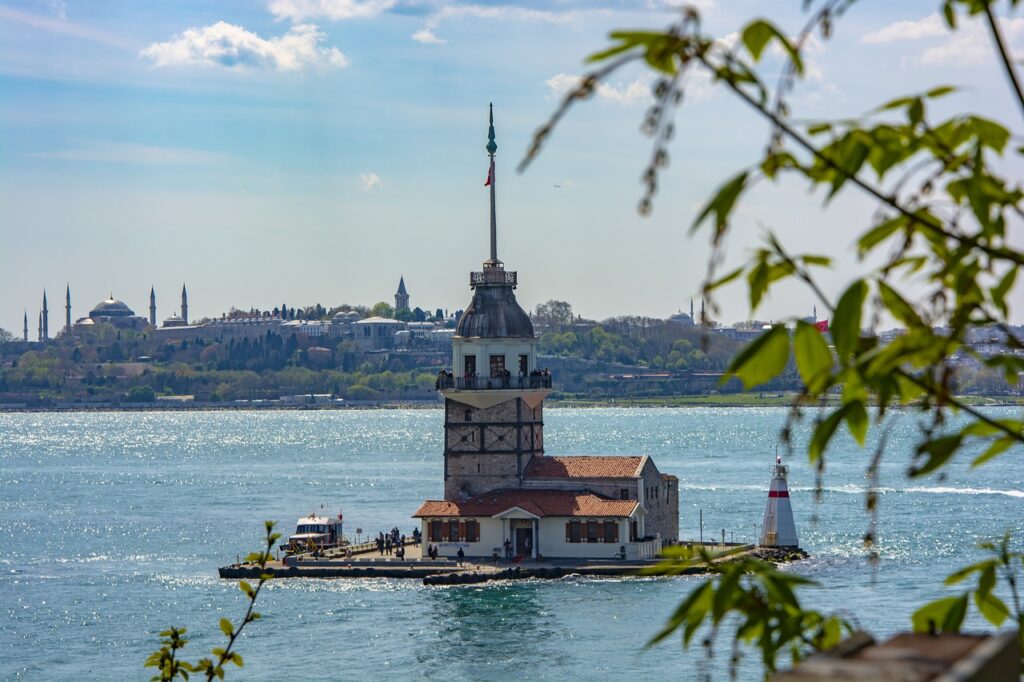A Mysterious Love Story; Maiden’s Tower
Having thousands of years of history, the Maiden’s Tower has been a symbol of love, passion, loneliness or inaccessibility, inspiring many artists, poets, painters, writers, musicians, directors and photographers throughout all this time.
Did you know the history of the Maiden’s Tower, an indispensable part of Istanbul’s urban fabric and the favorite frame of photographers, and its story that has been told for centuries?
The Maiden’s Tower, the only remaining structure from the Byzantine period in Üsküdar, dates back 2500 years. This unique structure has experienced a history equal to that of Istanbul and has been an eyewitness to what this city has experienced. With its history starting in ancient times, it has existed in all historical periods from Ancient Greece to the Byzantine Empire, from Byzantium to the Ottoman Empire, and has survived to the present day. Some European historians call it the Leander’s Tower.
The most impressive story of the Maiden’s Tower, which has many legends, is the immortal love story of two lovers who could not come together, “Hero and Leandros”.
It is also said that this legend emerged at the narrowest passage of the Dardanelles. However, today, perhaps because of its romantic texture, it is the most well-known story when it comes to the Maiden’s Tower.

According to the legend, there was a temple in the name of the Goddess Aphrodite on the hills of Üsküdar. The Hero mentioned in the story was one of the priestesses of this temple where young girls worked. Hero was responsible for looking after the doves in the Tower. Every year in the spring, ceremonies are held around the temple for the awakening of nature, and those who cannot find love pray to Aphrodite to be able to meet their dream lovers.
Leandros, who lives on the opposite shore of the Bosphorus, also comes to the temple to attend this ceremony and meets Hero. The two young people fall in love at first sight. However, there is a big obstacle between them. Hero is a priestess and it is forbidden for her to marry. However, Leandros wants to meet Hero at all costs. One night, while looking at the Tower from the shore, he sees a fire burning on top of the Maiden’s Tower. Hero guides Leandros with the torch in her hand. The calm sea is accompanied by the bright light of the moon. Leandros, a good and durable swimmer, jumps into the waters of the Bosphorus with the dream of reuniting with Hero. He starts swimming with all his might and reaches the Tower. The two young people bless their love that night.
From that day on, the Maiden’s Tower witnesses the secret love and forbidden lovemaking of the two young people every night. On a stormy night, Leandros throws himself into the wild waters of the Bosphorus to reunite with his one and only love, Hero. As she does every night, Hero guides Leandros with her torch. However, Hero’s torch, which guides her one and only love, goes out under the influence of the wind. Leandros, who loses his way in the darkness, does not know where to swim and moves further and further away from the Tower. Tired and exhausted, Leandros cannot stand it anymore and disappears in the dark waters of the Bosphorus. Hero, who waited for her lover until the morning with unbearable anxiety inside her, cannot bear this pain when she sees Leandros’ lifeless body on the opposite shore and throws herself into the waters of the Bosphorus from the Maiden’s Tower.
editor's pick
İstanbul’da baharın yüzünü yavaş yavaş göstermeye başladığı bugünlerde erguvanlar da şahane çiçekleriyle yüzlerini göstermeye başladılar. Peki erguvanların pembe-mor renkleriyle boğazın simgesi olduğunu biliyor muydunuz? İstanbul’un rengini değiştiren nadir ağaçlardan olan erguvanlar çiçek açtığı zaman İstanbul Boğazı harika bir renge bürünür. Nisan ortalarından Mayıs ortalarına kadar uzanan bir süreç içerisinde pembe-mor çiçekleriyle adeta İstanbul’a baharı müjdeler. Siz de baharın tadını İstanbul’da çıkarmayı planlıyorsanız erguvanların coşkuyla açtığı bu dönemi kesinlikle kaçırmamalısınız!
İstanbul’a yapacağınız geziniz boyunca İstanbul’da sürekli gördüğünüz nazar boncuklarının anlamını biliyor musunuz? Nazar boncuğu, tarih boyunca, çoğu kültürde ve dinsel inançta, kötülükleri savan güçlü bir tılsım olarak kabul edilmiştir. Genelde nazar boncukları göz şeklinde olur. Kişinin dünyaya açılan penceresi gözdür ve göz her türlü, iyi ve kötü, düşüncelerin ilk çıkış noktası olarak kabul edilir. Bu yüzden bakışlardan, kötü gözlerden korunmak amacıyla emici özelliği olduğuna inanılan mavi renkli taşlar eskiden beri nazar boncuğu yapımında kullanılmıştır ve son halini günümüzdeki çeşit çeşit nazar boncukları olarak almıştır. Şu an, gerek inanç gerek gelenek, gerekse de süs eşyası olarak pek çok kişi nazar boncuğunu günlük yaşantısında çok sık [...]
Çemberlitaş Hamamı; Çemberlitaş yanında, Kapalıçarşı yakınında bulunmaktadır. III. Murat’ın annesi Nur Banu Sultan tarafından, Üsküdar’daki Valide-i Atik Külliyesine kaynak sağlamak için 1584 yılında, Mimar Sinan’a yaptırılmıştır. Kadınlar ve erkekler kısımdan oluşan bu çifte hamam; Valide Sultan Hamamı, Gül Hamamı, isimleriyle de anılmış, Evliya Çelebi’yse III. Murat Hamamı olarak bahsetmiştir yapıdan. Bugün hamamın kadınlar bölümü ayakta olmamasına rağmen, geri kalan bölümü kadınlar ve erkekler için iki ayrı bölüme ayrılarak kullanılmaktadır. Günümüzde turistik hamam sefalarıyla yabancı konuklarını ağırlamaya devam eden hamam, Osmanlı hamam mimarisinin şaheserlerinden olmaya layık bir yapıdır.
news via inbox
Nulla turp dis cursus. Integer liberos euismod pretium faucibua





